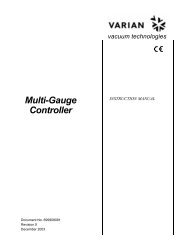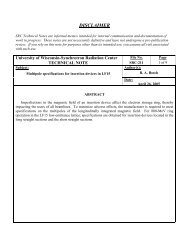SRC Users' Meeting - Synchrotron Radiation Center - University of ...
SRC Users' Meeting - Synchrotron Radiation Center - University of ...
SRC Users' Meeting - Synchrotron Radiation Center - University of ...
You also want an ePaper? Increase the reach of your titles
YUMPU automatically turns print PDFs into web optimized ePapers that Google loves.
Epitaxial strain in La 2-x Sr x CuO 4 : Fermi Surface change and T c enhancement.<br />
M. Abrecht 1* , D. Ariosa 1 , D. Cloëtta 1 , G. Margaritondo 1 , M. Onellion 2 , and D. Pavuna 1 .<br />
1 IPMC, School <strong>of</strong> Basic Sciences, Ecole Polytechnique Fédérale de Lausanne (EPFL)<br />
CH-1015 Lausanne, Switzerland<br />
2 Department <strong>of</strong> Physics, <strong>University</strong> <strong>of</strong> Wisconsin-Madison, Madison, WI-53706, USA<br />
Extended abstract<br />
Using our dedicated Pulsed Laser Deposition (PLD) system and in-situ Angle Resolved<br />
Photoemission Spectroscopy (ARPES) as opposed to the traditional cleaving or scraping <strong>of</strong><br />
samples in UHV, we measured the band dispersion <strong>of</strong> epitaxially strained La 2-x Sr x CuO 4<br />
(0.1x0.2) thin films to investigate the links between strain induced increase in<br />
superconducting transition temperature (T c ) and low energy electronic features. Such<br />
measurements are the first direct probing <strong>of</strong> the electronic structure <strong>of</strong> any high T c<br />
superconductor under epitaxial strain, and were made possible only thanks to our new approach<br />
<strong>of</strong> sample growth at the <strong>Synchrotron</strong> <strong>Radiation</strong> <strong>Center</strong>.<br />
We emphasize the importance <strong>of</strong> such measurements since strain has been known to increase<br />
substantially the superconducting properties <strong>of</strong> cuprates: the critical temperature <strong>of</strong> La 2-x Sr x CuO 4<br />
(LSCO) under epitaxial strain for example can reach 50K whereas for a non strained sample, the<br />
T c value does not exceed 39K whatever the Sr (doping) content [Locquet].<br />
Our APRES results on in-plane compressed films show a band dispersing along the k x reciprocal<br />
space direction and crossing the Fermi level before the Brillouin zone boundary (figure 1), in<br />
sharp contrast to a flat band staying well below the Fermi level for unstrained samples with equal<br />
doping [Ino]. Our results were confirmed on various sampes with different doping values x<br />
[Abrecht] using the Scienta analyzers <strong>of</strong> the <strong>SRC</strong>. Very surprisingly, the critical temperatures <strong>of</strong><br />
the strained samples are enhanced by more than 6 degrees despite a tremendous reduction <strong>of</strong> the<br />
density <strong>of</strong> states due to the disappearance <strong>of</strong> the saddle point near the Fermi level (figure 2).<br />
Based on a simple 2D tight binding approximation, we were able to predict the Fermi Surface<br />
evolution with doping and strain (figure 3), a simulation that proved accurate for both Ino’s bulk<br />
data [Ino] and our strained and unstrained film samples. Implications <strong>of</strong> our findings on possible<br />
superconducting mechanisms in the cuprates include that the van-Hove singularity is not<br />
essential to obtain high critical temperatures, and that T c =T c (x, ), where is a parameter related<br />
to strain that should be included in the Superconducting phase diagram.<br />
* Present address: National Institute <strong>of</strong> Standards and Technology, Magnetic Technology Division, 325 Broadway,<br />
Boulder CO-80305.
















